HRM Assignment: Managing Human Resources In Australian Retail Sector Post Covid-19
Question
Task:
You will write a report on HRM assignment discussing the key challenges for the workforce in your selected sector in managing human resources in the post-COVID19 context.
Answer
Executive summary
The HRM assignment highlights that the retail sector of Australia is facing a series of issues amid of COVID-19 situation. The HR managers are prominently facing issues in the management of successful remote working, health, and safety and ensuring the wellbeing of the workers. These chills are directly impacting the workers' productivity and business performance. The post-pandemic situation has created the new business needs of hybrid business models and training programs. These attributes are required to be addressed to harness the true power of human capital effectively. The use of hybrid working models can foster better opportunities and remote training can facilitate better employee competency to reach new heights in the business setting.
Introduction
The report will address the key challenges faced by the Australian workforce in the Retail sector in managing the human resources in the post-COVID-19 situation. The specific focus will be made on discussing department stores sub sector HRM issues and challenges. The discussion will be made to highlight the key HRM issues during and after a post-pandemic period. The discussion will cover the additional challenges triggered by the outbreak of COVID-19 in the context of human resource management. A succinct understanding will be gained regarding the present and future challenges concerning human resource management. Based on the conducted analysis the suggested strategies will be discussed to resolve issues of employee management.
Sector context
According to the IBIS World report findings, the revenue of the retail sector has experienced a reduction of around -0.0% each year on average between 2015-2020 to $407.6bn. This makes the retail industry the fastest growing industry within Australia over the prior five years (Ibisworld.com, 2022). Further, the number of businesses within the retail sector of Australia has grown -1.1% each year on average between 2015 and 2020 to 107,814 enterprises.
The retail sector is determined to be the fifteenth-ranked industry for business growth over the last five years. Moreover, the employment rate in the Australian retail sector has declined to -0.25 per year on average between 2015-2020 to 1,268,819 total employees, making it the ninth-ranked industry contributing to employment growth in the last five years (Ibisworld.com, 2022). The average wage in the retail trade sector in Australia in the FY2020 was $48.2bn, up from $47.3bn in FY2015. This reflects that AU retail trade industry has the seventh highest wage out of all AU other industries in FY2020 (Refer to appendix 1). The AU retail sector currently has 39 industries operating which range from Garden supplies retailing to supermarkets, clothing retailing, and grocery stores. The average profit margins of businesses within the retail trade in Australia in FY2020 were determined to be 4.6%.
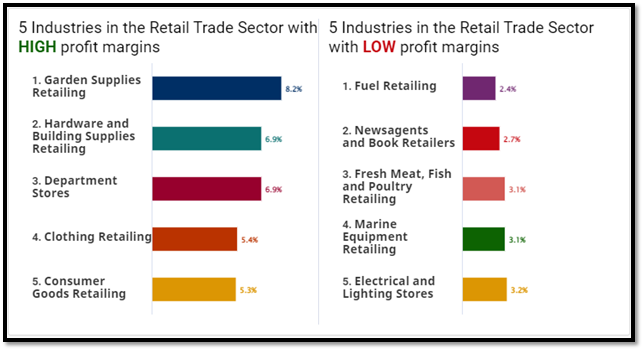
Figure 1: Subsectors in the retail sector with high and low-profit margins
(Source: Ibisworld.com, 2022)
The main five dominating industries in the retail sector making higher profit include Garden supplies retailing, Hardware and building supplies, department stores, clothing retailing, and consumer goods retailing (Ibisworld.com, 2022). On the other hand, the fuel retailing, newsagent and books retailers, fresh, meat and poultry retailing, marine equipment retailing, and electrical and lighting stores earn minimum profits in the Australian retail sector (Ibisworld.com, 2022).
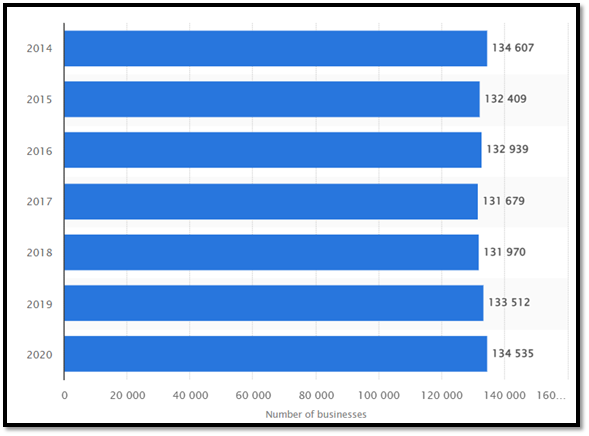
Figure 2: Number of retail companies operating in Australia FY 2014-2020
(Source: Statista.com, 2021)
In FY2020, there were approximately 134,535 businesses in the retail trade industry in Australia. After 2017 the number of retail companies recorded continuous growth (Statista.com, 2021).
Workforce challenges for the sector before the pandemic
Retention and employee turnover issues
As opined by Fleming et al., (2021), the lack of skills and capability development programs initiated by the HR managers contributes to the increasing rate of employee turnover. In the supermarket sector, the grocery stores and farm stores struggle in providing in facilitating required business training, technological training, and a wider range of skills sets. Access to training is important to ensure that job role are performed well which secures employee satisfaction. The lack of employee satisfaction can negatively impact the willingness to work which can lead to higher employee turnover. The HR managers are required to update the training programs to enhance the skills set of the employees. It will ensure the employees are capable enough to address the fragmentation levels of capabilities and skills required in the current digital era. Poor learning and development opportunities can be the major reason which can lead to employees feeling exhausted and unmotivated at the workplace. The Australian supermarkets due to these performance gaps face higher issues of retaining capable employees. According to Howe et al., (2019), food production is of critical importance within the Australian economy and ensures food security. The grocery stores of supermarkets face challenges of producing 93% of the total volume of food within Australia.
The findings reflect that the lack of compliance with workers' standards can lead to workers' disadvantages. The unfair practices such as inadequate pay rates by employers, paying lesser and different wages for different workers, no written piece of agreement increases the risk of employees leaving. The lack of adequate policies and procedures and adherence to the industry standards can lead to retention and higher turnover rates in the retail sector. For instance, the Guardian news article revealed that Woolworths underpaid thousands of workers by around $300m. It is considered Australia's biggest wage underpayment case in which 5,700 current staff were underpaid for around 9 years (Butler, 2019). This reflects the way recognized and well-established brands are engaged in breaching workplace laws and exploiting human rights which are leading to higher retention and employee turnover issues (Butler, 2019) (Refer to appendix 2).
Challenges in attraction and the recruitment of employees
The employers make strategic choices by recruiting temporary sponsored skilled migrants. Employer recruitments face three key challenges in attracting and recruiting employees which include issues in sourcing workers with particular skills and capabilities to better address skilled vacancies (Wright & Constantin, 2021). The second issue is lack of innovation knowledge which brings issues in fostering required news skills, ideas that can help human capital to perform better according to existing industry demands. Thirdly, the issue of cost-effectiveness leads to HR attracting cheap employees at lower rates. The addressing of human capital supply challenges within the supermarket sector is highly crucial. These issues can prevail due to a combination of factors such as lack of motivation and hard skills in the forms of experience and qualification among the workers.
The supermarket industry has complicated and sophisticated supply chains due to using cold chain technologies. The labor shortage is a major issue due to relative labor intensity. The supermarkets rely on recruiting migrant workers to save costs (Campbell, 2019). In FY2018, around 12.8% of workers were working in the food and beverages sector in the AFG meat processing. Further, in the same year, around 3.8% of workers in the same sector were engaged in the bread manufacturing product class (Statista.com, 2021). These workers are offered depressed wages to conduct grocery delivery operations and ensure a lower bottom line in the business. This reflects the HR facing issues in attracting local workers and over-dependency on the migrant workers to fill the vacancy gap by offering minimum wages (Campbell, 2019).
Challenges in succession and the training plans
The Australian franchisors face immense issues in growing the capacity of their supply chains. The franchisers are reasonable for ensuring direct employment of around 500,00 people however this growth is in threat due to a reduction of 50-80% of reduction in franchise inquiries in FY2017-18 (Balsarini, Lambert & Ryan, 2020). The externally recruited workers hired by the department stores like the competencies to conduct the expected job roles. The growing skills gap in the marketplace is making it difficult to hire employees. The franchise is independent business persons which lack the factor of expertise and endeavor to train the employees to meet the description of the job role. It is the major reason the growing retention, attraction, and talent management issues are prevailing in the franchisee sector. The lack of succession planning, financial resources, and supervision creates issues for new recruiters to perform well with confidence. These factors create a performance gap in the department sub-sector due to the absence of appropriate training programs deployment (Balsarini, Lambert & Ryan, 2020).
Labor and skill shortages
The labor market is slowly changing over time in Australia. The labor and lifestyle mobility are influencing the indigenous life of workers. The study has found that due to skills shortages employers hire seasonal workers (Anderson, 2018). However, the franchisors avoid investing in learning and development programs to ensure that the permanent workers have the necessary competencies and skills. Rather the investments are used to attract seasonal and migrant workers to meet the business needs. It reflects the ways temporary and short-term initiations are taken. It is the major reason departments stores lack the power to harness the true potential of local workers due to aiming for short-term business goals and targets (Anderson, 2018).
Workforce challenges for the sector during the pandemic
Issues in the management of remote working
The outbreak of COVID-19 created a series of health risks for the operating workers in Australia. This forces the department to implement remote working during unprecedented times. However remote working directly impacted the workers’ productivity and motivational levels to work due to the increased mental stress, increasing unemployment rates, and job security fears. These factors automatically affect the businesses and HR managers to manage the workers' motivation factors. The COVID-19 created emotional chaos which impacted the workers' career stages and development prospects. Thus the HR managers were under strenuous pressure to maintain the career development options and ensure growth prospects for the capable employees. The cutting down of the existing workforce event triggered the employees' fear across the different career stages (Toh et al., 2021).
The lockdown and shutdown of the business forced the implementation of remote working to ensure revenue streams flow in the business spheres (Restubog, Ocampo & Wang, 2020). According to the McKinsey report, finding remote work became the new business reality to sustain in the highly uncertain and volatile business environment. The HR professionals were under constant pressure to educate the workforce and maintain the well-paid minority of the workforce to continue the business operations (Lund et al., 2021). The forced quarantines and self-imposed isolation pushed millions of employees to adapt to work-from-home routines. The majority of the workforce faced immense issues to adapt according to the new remote working protocols which impacted the employee's performance due to lack of digital knowledge and expertise. The structural shift in the working practices increases the higher need for automation, digitalization, and technical management needs, expertise, and knowledge for the employees (Lund et al., 2021). It even forces the HR managers to facilitate technical training to reduce business risks and human errors. This depicts that remote working accentuates the degree of risks and inequalities at a social level as only competent workers can survive (Lund et al., 2021).
Challenges in motivating and supporting mental/wellbeing of employees
The ongoing COVID-19 upsurges health concerns and risks which created a chaotic scenario. Work engagement and wellbeing were the factors at the risk. The employees were forced to resign to maintain their well-being. These factors created labor shortages and a reduction in old age employees. The HR managers were exposed to the challenges to building the psychological resilience of the workforce. Amid COVID-19 the high mortality and morbidity rates were scary for the workforce. The coronavirus outbreak created emotional fear due to the increasing number of death rates and lack of medical supplies to tackle the situation. These events highly demotivated the workers and greeted serious concerns regarding the factors of health and career (Abbas & Zhiqiang, 2020). The public panic, mental stress, and vulnerable healthcare systems affected the mental wellbeing of the people. The older workers lacked the disaster preparedness, recovery, and response aspects. These factors created a series of challenges in maintaining the well-being of the workers and maintaining workforce productivity at the same time (Abbas & Zhiqiang, 2020).
The major challenges were faced in keeping the workforce motivated to attain the business targets and sustain. The HR managers were under constant pressure to weaken the protections offered to the workers. The mental health issues increased creating a mental burden on the existing workforce creating business risks scopes in the business spheres (Einboden et al., 2021). The poor working conditions due to lack of flexibility and proper support of full human capital led to poor results. In Between social and economic precocity, the workers were left with resigning to avoid poor treatment and sometimes endure our work placements to sustain. The Australian supermarket's contingency planning was failing due to extreme anxiety among the staff (Butler, 2022) (Refer to appendix 3). These attributes created a series of issues for the franchisors and HR to maintain workplace productivity and reach the business targets.
Issues in ensuring employees health and safety prospects
The occupational health issues were determined as new challenges for the HR managing the retail industry. The physical distancing, sanitization, and reduced workforce created the demand for additional financial resources to adhere to the health and safety standards fixed by the Australian government. The HR managers were forced to work half-human capital and maintain the health and safety aspects at the same time to avoid the closure of the business (Adikaram et al., 2021). The battling of COVID-19 effects on business has certainly put strenuous pressure on the human resource managers to ensure the safety of working employees.
The free distribution of safety kits and sanitization were mandatory to continue the business activities operations. The risk of possible spread and physical risk. The updated infection prevention action taking and control measures were highly mandatory for the workers operating in the mid-COVID-19 situation. The timely guidance of employees to specify the changing standards for workers' safety increased the pressure on the human resource managers (Adikaram et al., 2021).
Workforce challenges and recommendations for the sector in the post-pandemic period
The post-pandemic created the need for new business needs and demands. The traditional business model lacks the efficiency to provide the desired results post endemic. The higher importance of hybrid business models was increased by focusing on both remote and on-site working practices (Alexander, Smet & Mysore, 2021). The HR practices have learned from past mistakes about the significance of remote training to improve the worker's competencies and expertise. T is the major reason the post-pandemic trends include the consideration of hybrid business models in the business and remote training. The recommended strategies for the retail sector are discussed below:
Need for Hybrid virtual model by combining both remote and on-site working
According to a McKinsey report, the post-pandemic has highlighted the need for hybrid virtual business models that allows greater access to aspects of talents, increased productivity of workers, and lower costs. It even increases the factor of flexibility in the business and improved employee experience can be guaranteed (Alexander, Smet & Mysore, 2021). History has reflected that the mixing of virtual and on-site working practices is harder to implement however it was successful post-pandemic. The organizational norms often impact ways of working, behavior, and interactions. Often the hybrid virtual business models create a common culture, build shared trusts and generate social cohesion among the employee's group. Thus, the new business reality and working practices will be needed to focus on the execution of hybrid working business models.
Significance of online remote training for the workforce
According to the forest report, remote training is an online solution to better manage the employees (Forbes.com, 2020). It can help employers to improve the existing competencies and skills of the employees. The employees will have the learning opportunity to transform according to the changing industry requirements and stay competitive shortly (Forbes.com, 2020).
References
Abbas, S. M., & Zhiqiang, L. (2020). COVID19, mental wellbeing and work engagement: The psychological resilience of senescent workforce. International Journal of Research in Business and Social Science (2147-4478), 9(4), 356-365. https://www.ssbfnet.com/ojs/index.php/ijrbs/article/download/760/610
Adikaram, A. S., Naotunna, N. P. G. S. I., & Priyankara, H. P. R. (2021). Battling COVID-19 with human resource management bundling. Employee Relations: The International Journal. https://www.emerald.com/insight/content/doi/10.1108/ER-08-2020-0390/full/html?utm_source=rss&utm_medium=feed&utm_campaign=rss_journalLatest
Alexander, A., Smet, A.D. & Mysore, M., 2021. Reimagining the post-pandemic workforce. McKinsey & Company. Available at: https://www.mckinsey.com/business-functions/people-and-organizational-performance/our-insights/reimagining-the-postpandemic-workforce [Accessed February 3, 2022].
Anderson, E. (2018). Belonging, temporariness and seasonal labor: working holiday makers' experiences in regional Australia. In Work and identity (pp. 117-131). Palgrave Macmillan, Cham. https://eprints.usq.edu.au/34249/8/Anderson_Chapter%2010_AV.pdf
Balsarini, P., Lambert, C., & Ryan, M. M. (2020). Why franchisors recruit franchisees from the ranks of their employees. Journal of Strategic Marketing, 1-21. https://www.tandfonline.com/doi/pdf/10.1080/0965254X.2020.1733053
Butler, B. 2019. Woolworths underpaid thousands of workers by up to $300M. The Guardian. Available at: https://www.theguardian.com/business/2019/oct/30/woolworths-underpaid-thousands-of-staff-by-up-to-300m [Accessed February 3, 2022].
Butler, B., 2022. Chronic staff shortages, 2 am starts, and extreme anxiety: Inside a Coles Supermarkets Supply Warehouse. The Guardian. Available at: https://www.theguardian.com/world/2022/jan/19/employee-in-coles-supply-chain-says-a-quarter-of-staff-on-leave-due-to-covid [Accessed February 3, 2022].
Campbell, I. (2019). Harvest labor markets in Australia: Alleged labor shortages and employer demand for temporary migrant workers. Journal of Australian Political Economy, (84), 46-88. https://www.ppesydney.net/content/uploads/2020/05/Harvest-labour-markets-in-Australia-Alleged-labour-shortages-and-employer-demand-for-temporary-migrant-workers.pdf’
Einboden, R., Choi, I., Ryan, R., Petrie, K., Johnston, D., Harvey, S. B., ... & Deady, M. (2021). 'Having a thick skin is essential: mental health challenges for young apprentices in Australia. Journal of Youth Studies, 24(3), 355-371. https://www.tandfonline.com/doi/abs/10.1080/13676261.2020.1728240
Fleming, A., Jakku, E., Fielke, S., Taylor, B. M., Lacey, J., Terhorst, A., & Stitzlein, C. (2021). Foresighting Australian digital agricultural futures: Applying responsible innovation thinking to anticipate research and development impact under different scenarios. HRM assignment Agricultural Systems, 190, 103120. https://www.sciencedirect.com/science/article/pii/S0308521X21000731
Forbes.com., 2020. Council post: The future of work: Improving workforce training and employee experience. Forbes. Available at: https://www.forbes.com/sites/theyec/2020/05/19/the-future-of-work-improving-workforce-training-and-employee-experience/?sh=48112db23044 [Accessed February 3, 2022].
Howe, J., Clibborn, S., Reilly, A., van den Broek, D., & Wright, C. F. (2019). Towards a durable future: Tackling labor challenges in the Australian horticulture industry. https://apo.org.au/sites/default/files/resource-files/2019-01/apo-nid233856.pdf
Ibisworld.com. 2022. Industry market research, reports, and Statistics. IBISWorld. Available at: https://www.ibisworld.com/au/sector-profiles/retail-trade/ [Accessed February 3, 2022].
Lund, S., Madgavkar, A., Manyika, J., Smit, S., 2021. What's next for remote work: An analysis of 2,000 tasks, 800 jobs, and nine countries. McKinsey & Company. Available at: https://www.mckinsey.com/featured-insights/future-of-work/whats-next-for-remote-work-an-analysis-of-2000-tasks-800-jobs-and-nine-countries [Accessed February 3, 2022].
Restubog, S. L. D., Ocampo, A. C. G., & Wang, L. (2020). Taking control amidst the chaos: Emotion regulation during the COVID-19 pandemic. Journal of vocational behavior, 119, 103440. https://www.ncbi.nlm.nih.gov/pmc/articles/pmc7206430/
Statista.com. 2021. Australia - employment distribution in the food and beverage sector by product class. Statista. Available at: https://www.statista.com/statistics/639903/australia-employment-distribution-in-the-food-and-beverage-sector-by-product-class/ [Accessed February 3, 2022].
Statista.com. 2021. Australia: Number Retail Trade Businesses 2020. Statista. Available at: https://www.statista.com/statistics/932646/australia-number-retail-trade-businesses/ [Accessed February 3, 2022].
Toh, W. L., Meyer, D., Phillipou, A., Tan, E. J., Van Rheenen, T. E., Neill, E., & Rossell, S. L. (2021). Mental health status of healthcare versus other essential workers in Australia amidst the COVID-19 pandemic: Initial results from the collate project. Psychiatry Research, 298, 113822. https://www.ncbi.nlm.nih.gov/pmc/articles/pmc7902230/
Wright, C. F., & Constantin, A. (2021). Why recruit temporary sponsored skilled migrants? A human capital theory analysis of employer motivations in Australia. Australian Journal of Management, 46(1), 151-173. https://journals.sagepub.com/doi/pdf/10.1177/0312896219895061
Appendices
Appendix 1: Financial highlights of Australian retail industry
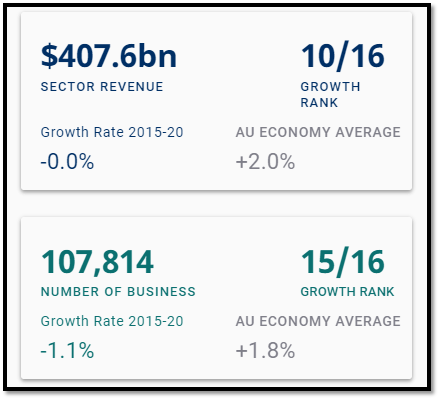
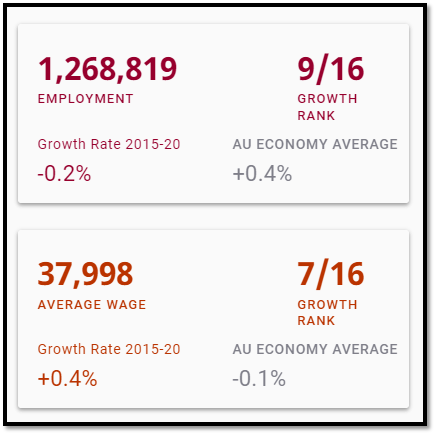
(Source: Ibisworld.com, 2022)
Appendix 2: The Guardian news article reveals Woolworths underpaid workers for around 9 years
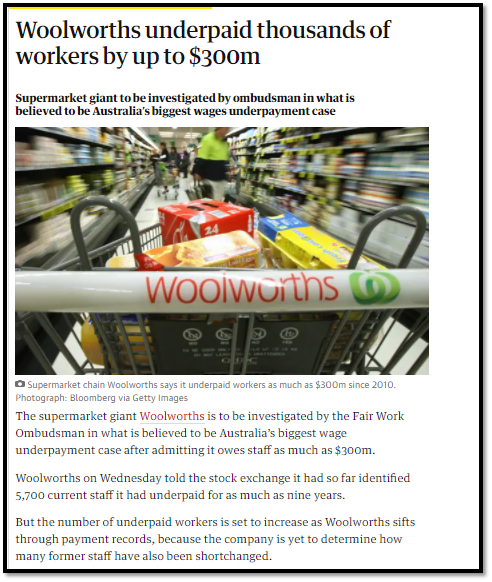
(Source: Butler, 2019)
Appendix 3: The Guardian news on extreme anxiety among supermarket workers of Australia
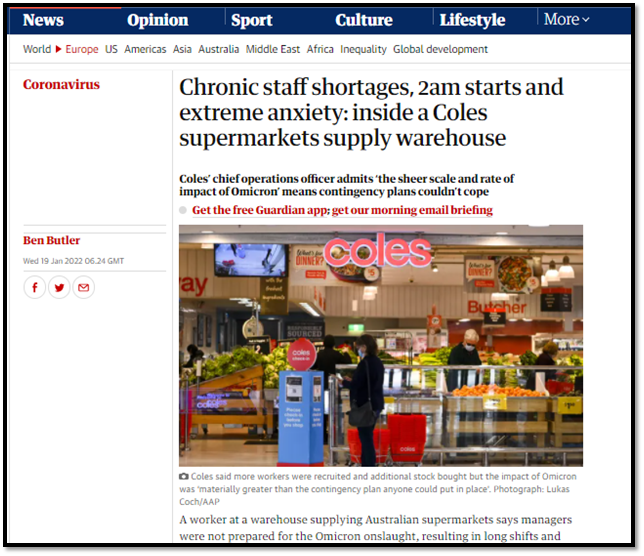
(Source: Butler, 2022)












